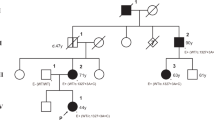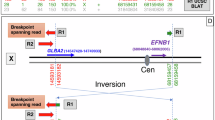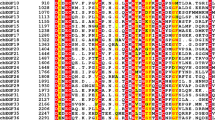Abstract
Fibrillin-1 is a multifunctional extracellular protein encoded by the FBN1 gene. FBN1 is 237 kb in size and is located on chromosome 15q21. FBN1 mutations are known to cause Marfan syndrome and other fibrillinopathies. FBN1 is composed of 65 exons and 3 additional alternatively spliced exons at the 5′ end. The absence of the peptide sequence from the extreme N-terminus of the fibrillin-1 protein and the presence of in-frame and alternatively spliced exons at the 5′ end of the FBN1 gene create some ambiguity about the translation start site and indicate a functional role of these alternatively spliced exons. We demonstrate here the conservation of 5′-upstream region of the FBN1 gene among humans and non-human primates.
Similar content being viewed by others
Log in or create a free account to read this content
Gain free access to this article, as well as selected content from this journal and more on nature.com
or
References
Sakai LY, Keene DR, Engvall E : Fibrillin, a new 350-kD glycoprotein, is a component of extracellular microfibrils. J Cell Biol 1986; 103: 2499–2509.
Pereira L, Andrikopoulos K, Tian J et al: Targeting of the gene encoding fibrillin-1 recapitulates the vascular aspect of Marfan syndrome. Nat Genet 1997; 17: 218–222.
Mecham RP, Heuser JE : The elastic fiber; in Hay ED (ed): Cell Biology of Extracellular Matrix. New York: Plenum, 1991, pp 79–109.
Magenis RE, Maslen CL, Smith L, Allen L, Sakai LY : Localization of the fibrillin (FBN) gene to chromosome 15, band q21.1. Genomics 1991; 2: 346–351.
Biery NJ, Eldadah ZA, Moore CS, Stetten G, Spencer F, Dietz HC : Revised genomic organization of FBN1 and significance for regulated gene expression. Genomics 1999; 56: 70–77.
Milewicz DM, Grossfield J, Cao SN, Kielty C, Covitz W, Jewett T : A mutation in FBN1 disrupts profibrillin processing and results in isolated skeletal features of the Marfan syndrome. J Clin Invest 1995; 95: 2373–2378.
Corson GM, Chalberg SC, Dietz HC, Charbonneau NL, Sakai LY : Fibrillin binds calcium and is coded by cDNAs that reveal a multidomain structure and alternatively spliced exons at the 5′ end. Genomics 1993; 17: 476–484.
Kozak M : An analysis of vertebrate mRNA sequences: intimations of translational control. J Cell Biol 1991; 115: 887–903. Review.
Tan FK, Wang N, Kuwana M et al: Association of fibrillin 1 single-nucleotide polymorphism haplotypes with systemic sclerosis in Choctaw and Japanese populations. Arthritis Rheum 2001; 44: 893–901.
Kodera T, Tan FK, Sasaki T, Arnett FC, Bona CA : Association of 5′-untranslated region of the fibrillin-1 gene with Japanese scleroderma. Gene 2002; 297: 61–67.
Singh KK, Shukla PC, Rommel K, Schmidtke J, Arslan-Kirchner M : Sequence variations in the 5′ upstream regions of the FBN1 gene associated with Marfan syndrome. Eur J Hum Genet 2006; 14: 876–879.
Author information
Authors and Affiliations
Corresponding author
Additional information
Supplementary Information accompanies the paper on European Journal of Human Genetics website (http://www.nature.com/ejhg)
Supplementary information
Rights and permissions
About this article
Cite this article
Singh, K., Shukla, P. & Schmidtke, J. Conservation of 5′-upstream region of the FBN1 gene in primates. Eur J Hum Genet 16, 869–872 (2008). https://doi.org/10.1038/ejhg.2008.51
Received:
Revised:
Accepted:
Published:
Issue date:
DOI: https://doi.org/10.1038/ejhg.2008.51



